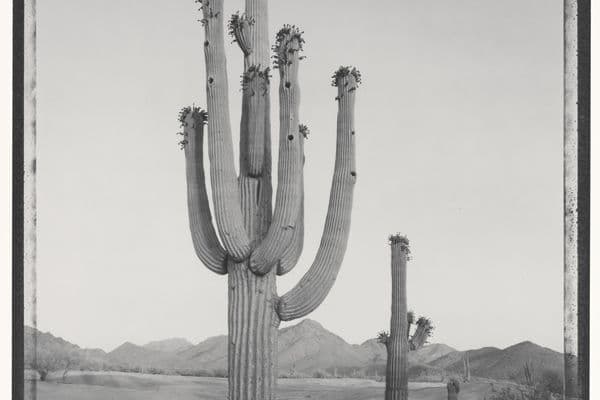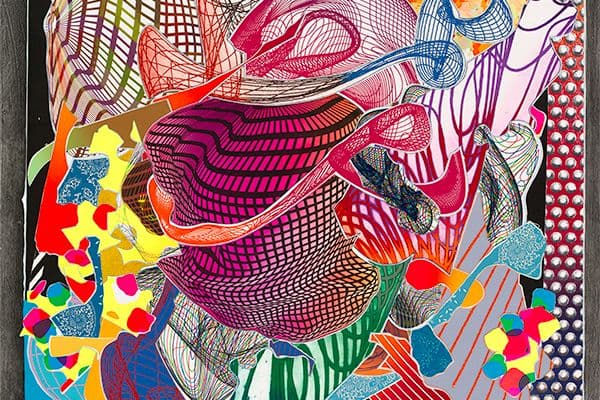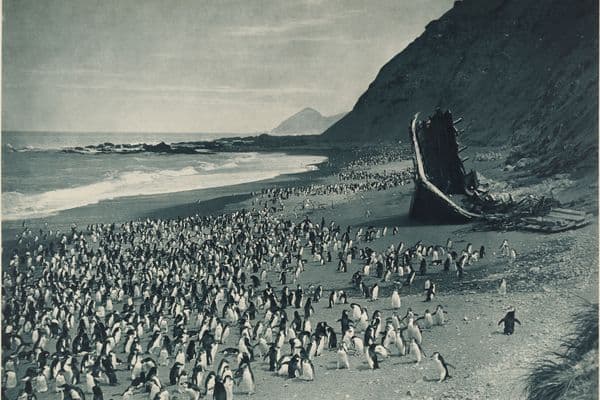Abracadabra
The magic in conservation
28 Jul 2006 – 26 Nov 2006

Ultraviolet image revealing locations of repairs and restorations.
Han dynasty, China, Saddled horse, 25-220 CE, Gift to the National Collection of Asian Art from Mr TT Tsui JP through the NGA Foundation 1994
About
Abracadabra is an overview of conservation techniques that reveal the mysteries hidden in works of art.
Children will be able to use ultra violet light, magnification, X-ray games and computer technology to see invisible drawing in paintings, discover hidden repairs in ceramics and to see the internal structures of costumes and puppets.
Exhibition Pamphlet Essay

X-ray image of Alexandra Exter, Sandwich man [L’homme sandwich], 1926, watercolour and collage on cardboard with wood, cotton, string, book cloth, copper, sequins, steel tacks, bridge nails, steel wire and eyelets. National Gallery of Australia.

Ultraviolet image revealing locations of repairs and restorations. Han dynasty China, Saddled horse, 206 BCE – 220 CE, earthenware. National Gallery of Australia. Gift of Mr TT Tsui JP through the NGA Foundation.

Infrared image showing pencil grid lines in the centre of the painting. Eric Wilson, Domestic interior, 1935, oil on canvas on plywood. National Gallery of Australia.

Photomicrograph of Pair of woman’s slippers showing the fine construction of its decorative elements; metallic thread, sequin, bead and embroidery
In Abracadabra: the magic in conservation National Gallery of Australia conservators unpack their repertoire of ‘magic tricks’, to present fascinating techniques that reveal information hidden within the material structure of works of art. Such discoveries remain fresh and exciting, no matter how often are made, and it is this sense of magical revelation that the exhibition aims to convey. The science behind x-rays, infrared reflectography, ultraviolet fluorescence and microscopy can be complex but the hey presto! effects are a constant source of wonder and delight.
In contrast to such revelations, some aspects of conservation practice require conservators to put as much effort into concealment as they put into unlocking secrets. Considerable expertise is needed to carry out undetectable repairs, or to mimic original colour using an entirely different medium. Deceptive disguise – rather than restoration – may be the only option where damage exists on a relatively large scale. Conservators develop and practice various strategies for camouflaging their work. Abracadabra is based on the dual themes of hiding and revealing; stylistically it borrows from the showmanship of magicians, and it is designed around works of art with strong visual appeal to children.
X-radiography is a medical imaging technique adopted by museum conservators. The process involves passing high energy radiation through objects onto photographic film, to form a radiograph. The x-ray film records differences in material densities. The varying absorption rates are displayed in the radiograph as gradations from light to dark; the greater the density the higher the absorption, resulting in a lighter image. Metallic elements absorb radiation more than non-metallic materials. X-radiography provides conservators with detailed information about the concealed structure of works of art, including changes made to paint layers, armatures inside costumes, or other internal supports.
The lively and colourful Futurist puppets, Sandwich man [L’Homme sandwich] 1926 and Publicity man [L’Homme reclamé] 1926, by the Russian artist Alexandra Exter, were x-rayed in the Gallery's conservation laboratory. The unique, fully-articulated puppets were designed for a film, and personify different types of advertising. Exter was influenced by the Cubist and Futurist movements, working mainly in theatre set and costume design, and on illustrated children’s books.
The artist used materials that every child has encountered, and often incorporated into their own art. The skeleton is made of wood and cotton reels, and is covered with an outer skin of painted card, collage, fabric, string and sequins.
The x-rays identify the presence of random metallic nails, screws and eyelets in the arm, leg and head structures. These images show the location of inherent weaknesses in the construction of the puppets, revealing that the suspension of the marionettes depends on delicate string and fabric to carry the full weight of the object. This information has enabled conservators to make minor modifications that keep the puppets safe for handling, display and storage.
Ultraviolet light is high energy light that literally translates as ‘beyond violet’; violet being the shortest wavelength we can see. Ultraviolet illumination exposes a secret world of fluorescing patterns not visible in normal light. Certain materials absorb ultraviolet light and fluoresce to a lesser or greater degree in a wide range of colours. Conservators can use this information to identify pigments, paint media and varnishes, as well as previous repairs and restorations. An awareness of the location of previous restoration can be crucial for conservators when assessing works of art for treatments, storage, transport or display. Art dealers also use ultraviolet to authenticate collectibles.
The Han dynasty Saddled horse from China is fairly representative of the extensive restoration found in similar funerary ceramics from Chinese burial sites. Large areas of ceramic loss have been so skilfully restored that the most experienced eye would find it difficult to differentiate repaired and original areas. Under ultraviolet light the restored areas become immediately apparent, as they fluoresce dramatically in contrast to the surrounding areas.
Infrared reflectography relies on the capacity of carbon-based materials to absorb energy in the infrared region. Images of pencil or charcoal underdrawing lying beneath layers of paint and varnish can be captured using infrared lamps, photographic filters and computer software. Preparatory sketches can add to curatorial knowledge of an artist’s technique.
Underdrawing found on paintings by William Strutt and Eric Wilson demonstrate two very different approaches to the construction of a painting.
In Domestic interior 1935, Wilson used a grid system to methodically transfer a preparatory sketch to his canvas. The original drawing was probably highly finished and composed to fit a circular format. Wilson’s execution is assured and there is no indication that the artist made any compositional changes during painting. The stillness and peace of the domestic circle, presided over by the artist’s mother and confirmed and punctuated by the comfortable cat in the foreground, imply that this is a close family living securely within a well-defined social framework. Everything about this painting speaks of planning, method and order; the discovery of the pencilled grid supports this view.
William Strutt, in his companion works from 1889, Cultivating an acquaintance and A warm response, created two charming paintings that record a flurry of action. His underdrawing is spontaneous and loose. The difficulties he encountered during the execution of his vignette can be seen in the changes he made at the preparatory stages and later as he was laying down the paint. Strutt provided himself with several pencilled alternatives for the position of the curious puppy’s tail, he repainted the position of the head several times. In the second painting the artist rearranged the puppy’s howling jaw in both pencil and paint. Infrared imaging also shows that he completed the lobster claw in the foreground, but subsequently lengthened and remodelled it.
Microscopy is one of the most frequently used diagnostic tools in the conservation laboratory. Coupled with sophisticated analytical techniques including polarised light, reactive staining, fluorescence and chemical spot-testing, it can be used to comprehensively identify textiles and paper fibres, paint media and pigments. Employed routinely to magnify surface detail on works of art, microscopy provides information about material content and structure, artist’s techniques and the condition of component materials.
For example, magnification can show how well a flaking pigment is adhered to the underlying support, or it may reveal an unexpected intricacy in the structure of a decorative textile thread. Conservation treatments are often carried out under magnification to assist with detailed work, such as the consolidation of friable ochre on a bark painting, or repairs to fragile textiles requiring tiny stitches sewn in very fine thread.
A Pair of Women’s slippers worn by members of the Peranakan Chinese community in Malaysia, featured in Abracadabra, has such delicate and tiny ornamentation that microscopic examination was necessary to evaluate the materials and establish the methods of manufacture. The base cream-coloured fabric is silk velvet. Satin stitch embroidery in very fine silk thread has been laid over padded formwork to create sheen of a high lustre.
The metallic thread was constructed from extremely fine strips of gold-plated, beaten copper wrapped around a silk core. Very fine copper wire was formed into circles, beaten flat and gold-plated to produce tiny sequins which are secured to the velvet by coiled, gold-plated copper wire held tight by silk thread. White glass beads, the size of the head of a pin, nestle in the embroidery and the toe of the slipper is edged with woven purple braid. The scale and finesse of this work is breathtaking.
The focus of Abracadabra is on the visually exciting imagery produced when conservation science meets a work of art. It is designed primarily for children from five to twelve years, with several exhibits offering interactive opportunities that use or simulate conservation procedures. We hope the exhibition will intrigue and delight children and adults alike.
Sheridan Roberts, Jaishree Srinivasan, Fiona Kemp and Stefanie Woodruff
Conservation Department










